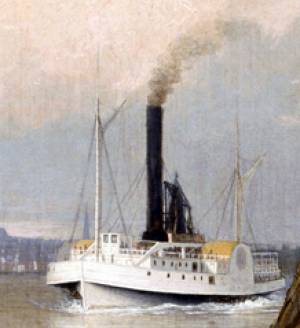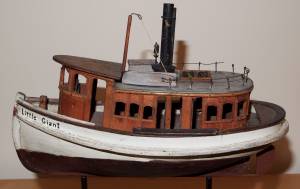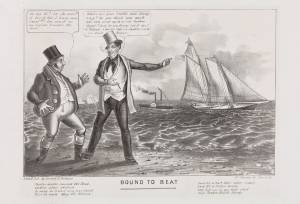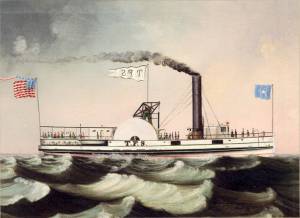An online project under the direction of the CAPE ANN MUSEUM
inv. 186
Steamer "Harvest Moon," Lying at Wharf in Portland
Steamer, "Harvest Moon"
1863 Graphite and photograph on paper 1 sheet of paper 9 3/4 x 10 1/2 in. (24.8 x 26.7 cm) Inscribed: below drawing (in pencil): Lying at Wharf in Portland; Inscribed lower left (in pencil): Painting made by Lane / from the Photograph 1863; Inscribed lower center (in pencil): for Lang + Delano / India Wharf / Boston; Inscribed lower right (in pencil): Introducing her into a sketch of Portland Harbor / taken on our visit in August 1863
|
Explore catalog entries by keywords view all keywords »
Historical Materials
Below is historical information related to the Lane work above. To see complete information on a subject on the Historical Materials page, click on the subject name (in bold and underlined).
Essay to come.
Long Wharf was built in the eighteenth century from the shore of Town Cove, one thousand feet into the harbor. Eventually it was joined by Central Wharf and a new Custom House was built between the two in the 1830s. In the 1850s the State Street Block was built on more of the dock. In 1808 to the south of Long Wharf, India Wharf was incorporated as part of the development of Town Cove. The wharf was designed by Charles Bulfinch. Construction was difficult and foundation stones had to be placed by men working in wooden diving bells. (1)
(1) W.H. Bunting. Portrait of a Port, Boston: 1852-1914. Cambridge: Harvard University Belknap Press, 1971, p. 48.
The "Harvest Moon" was a side-wheel steamer, 546 tons displacement and 193 feet in length, beam 29 feet and 8 feet draft. She was commissioned on February 12,1864 at Boston by Charles Spear, and launched in 1863 at Portland, Maine. She was acquired by Commodore Montgomery November 16, 1863. She sank in Winyah Bay, South Carolina February 29, 1865 and was abandoned on 21 April of that year.
There appears to have been a Lane painting of 1863: "Oil painting of the Harvest Moon." The present location of the original is unknown.
"Engine-powered vessel" is a collective term used by nautical historians to include all vessel types using engine power of any type for propulsion, whether assisted by sails, oars, or other motive power. In Lane's time, steam reciprocating engines fueled by wood or coal were the only practical source of this power for ships using paddle-wheels or screw propellers to convert heat energy into motion.
For most of the nineteenth century, steamships had sails for auxiliary power; indeed the earliest examples relied principally on sails, using engine power in calm weather to shorten the voyage time or keep to a schedule. As engines became more efficient, powerful, and reliable, sail plans were reduced, to be used only to steady a vessel's motion in a seaway (for the sake of seasick passengers), or to maintain headway if the engine broke down. Only harbor craft, ferry boats, and coastwise passenger steamers relied solely on engine power.
Among Lane's depictions of steamships, the auxiliary steam packet Auxiliary Steam Packet Ship Massachusetts (inv. 442) is a good example of primary reliance on sails, while the steam demi-bark The "Britannia" Entering Boston Harbor, 1848 (inv. 49) and the Cunard Liner "Britannia", 1842 (inv. 259) have relegated sails to secondary (or simply emergency) motive power.
– Erik Ronnberg
Castine Historical Society Collections (2015.03)
Also filed under: Historic Photographs » // Steamers »
Published by James French, Boston
Volume 1848-49
Boston Public Library
Call number 39999059856813
See p. 30 of directory.
Also filed under: "Britannia" (Cunard Steamship) » // "Caledonia" (Cunard Steamship) » // Trade Routes and Statistics »
Cartoon
9 1/4 x 13 3/4 in (23.495 x 34.925 cm)
Peabody Essex Museum, Salem, Mass.
Jonny and a Yankee:
Jonny: "Ho my Hi! 'ow she goes!! it his'nt fair I ham sure t'aint!!! She must 'av an engine hunder the keel..."
Yankee: "Where are your yachts now, Jonny? s-a-y- Do you think your wash tubs can come up to a real Yankee Clipper? Sorry for you, Jonny, but it can't be helped... A Yankee Ship a Yankee Crew, you know Jonny."
Also filed under: "America" (Schooner Yacht) »
Lithograph
Library of Congress Catalog Number 2002706878
Design of side wheel steamer showing wheel mechanism, side view and cross-section in ten figures. This design proved a failure in the few vessels that employed it. The paddle wheel enclosures filled with water, causing resistance which greatly impaired efficiency and increased fuel consumption.
– Erik Ronnberg
Oil on canvas
Maine Maritime Museum
Also filed under: Castine »
Steamer schedules for 1855, including the schedule for the steamer, "T. F. Secor" which served Castine, see pp. 234–35.
Also filed under: "T. F. Secor" (Steamboat) » // Castine » // Publications » // Steamers »
Provenance (Information known to date; research ongoing.)
Marks & Labels
Marks: Inscribed upper left (in red ink): 33 [numbering system used by curator A. M. Brooks upon Samuel H. Mansfield's donation of the drawings to the Cape Ann Museum]








Related Work in the Catalog